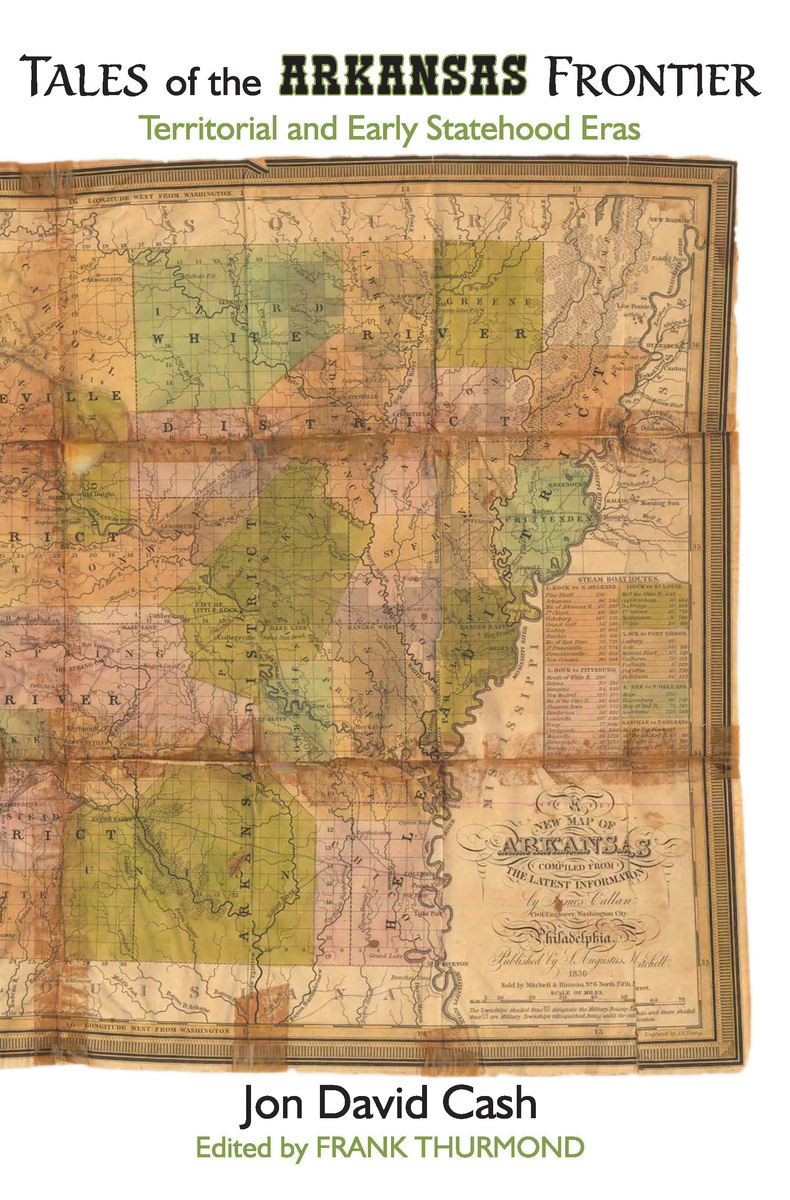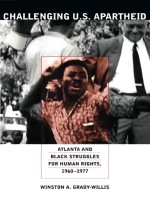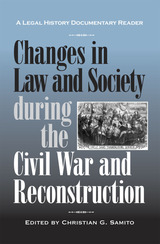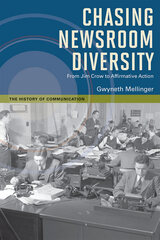TALES OF THE ARKANSAS FRONTIER: Territorial and Early Statehood Eras
by JON DAVID CASH
edited by Frank Thurmond
edited by Frank Thurmond
Parkhurst Brothers, Inc., 2025
Paper: 978-1-62491-211-5 | eISBN: 978-1-62491-210-8
See other books on: Revolutionary Period (1775-1800) | South (AL, AR, FL, GA, KY, LA, MS, NC, SC, TN, VA, WV) | Territorial | Thurmond, Frank | Wars & Conflicts
See other titles from Parkhurst Brothers, Inc.
Paper: 978-1-62491-211-5 | eISBN: 978-1-62491-210-8
ABOUT THIS BOOK | AUTHOR BIOGRAPHY | REVIEWS | TOC
ABOUT THIS BOOK
Tales of the Arkansas Frontier by Jon David Cash is for both students of history and those who are simply curious about the past. Cash’s accessible style of writing and storytelling introduces the reader to the names and amazing stories behind well-known cities and counties in Arkansas.
AUTHOR BIOGRAPHY
Jon David Cash, a native of Crossett in southeastern Arkansas, received bachelor’s degrees in History and Political Science and a Master’s degree in History from the University of Arkansas at Fayetteville before earning his PhD in American History at the University of Oregon. His first book, Before They Were Cardinals: Major League Baseball in Nineteenth-Century St. Louis (University of Missouri Press, 2002), based on his doctoral dissertation, was named a finalist in 2003 for the Seymour Medal awarded annually to the year’s best book of baseball history or biography by the Society for American Baseball Research (SABR). Its follow-up, Boom and Bust in St. Louis: A Cardinals History, 1885 to the Present, was recently released by McFarland Publishers in 2020. He taught at a half-dozen colleges or universities in Oregon, Arkansas, and Georgia, and his historical articles have appeared in California History: Quarterly Magazine of the California Historical Society; Arkansas Review: A Journal of Delta Studies published by Arkansas State University; and in the journals of both historical societies in Missouri, Missouri Historical Review published by the State Historical Society of Missouri in Columbia and Gateway Heritage published by the Missouri Historical Society in St. Louis. He died at his home in Crossett in 2022 shortly after completing this book for publication.
REVIEWS
Jon David Cash has produced an engaging and highly readable account of Arkansas’s early history, deftly moving from the Quapaws’ interactions with European colonial powers to important nineteenth-century political events and some leading personalities who participated in them. The reader will encounter vivid descriptions of frontier dueling, bear hunting, the state’s participation in the Mexican-American War, and the town of Napoleon’s disappearance into the Mississippi River. Along the way, documentary interludes illuminate the text: excerpts from the writings of G. W. Featherstonhaugh, Frederich Gerstaecker, Charles Fenton Mercer Noland, Thomas Bangs Thorpe, William Minor Quesenbury, and even Mark Twain contribute context and texture to the story. Arkansas’s historiography is richer for Cash’s work.
— Morris S. Arnold, author of Colonial Arkansas: A Social and Cultural History, 1686-1804 and The Rumble of a Different Drum: The Quapaws and Old World Newcomers, 1673-1804"Start with some stabbings, bear hunts and duels and you’ll get the kind of history that ought to regale any reader. Seriously folks, you couldn’t make this stuff up about life on the American frontier and you sure won’t find a better storyteller than Jon Cash.
Cash renders an excellent account of how one state and its cast of characters – some fascinating and some downright mean – helped shape the early United States. He is a gifted historian and a delightful storyteller as well."
— Rod Lorenzen, journalist and former director of Butler Center PublishingCash renders an excellent account of how one state and its cast of characters – some fascinating and some downright mean – helped shape the early United States. He is a gifted historian and a delightful storyteller as well."
"Tales of the Arkansas Frontier by Jon David Cash is for both students of history and those who are simply curious about the past. Cash’s accessible style of writing and storytelling introduces the reader to the names behind well-known cities and counties in Arkansas, such as Conway, Crittenden, and Yell, and even includes tales of bear hunting and Mark Twain’s time on the Mississippi River."
— Kimberly Rush, Ph.D., author of Historic Photos of Little Rock"Tales of the Arkansas Frontier: Territorial and Early Statehood Eras is a book that will appeal to professional historians, general readers, and students of U.S. and Arkansas history. The documents in this collection exemplify important national themes from the antebellum period. Cash presents a “vibrant living enigma of colorful characters” that never fails to illuminate and entertain. A well-written introductory essay chronicles Arkansas history from the seventeenth century to the late nineteenth century, examines major themes of the period, and sets the stage for the documents that follow. A series of fatal frontier duels in the 1820s, a gripping knife-fight on the floor of the Arkansas House of Representatives in 1837 that left one of the participants mortally wounded, bear-hunting on the Little Red River, and steamboats bustling along the mighty Mississippi – famously described by Mark Twain – provide some of the scenes that greet the reader on these pages. The fascinating stories of Archibald Yell and “Cush” Quesenbury chronicle the expansion of the southern frontier as the country grew from coast to coast in the 1840s and add accounts of their military exploits to an already lively collection. Importantly, Cash provides thorough scholarly annotation with more than 150 references that cite nearly 200 published works and document collections. Combining entertaining and elucidating tales with careful scholarship, this book will no doubt find its way into history classrooms on university campuses and enjoy a wide general readership outside academia."
— Thomas Daniel Knight, Professor of American History at the University of Texas – Rio Grande Valley, and editor of Contemners and Serpents: The James Wilson Family Civil War Correspondence"It is wonderful to have this important collection of early Arkansas historical sources available in one volume. No other aspect of Arkansas history is more important than our territorial and early statehood days. The strength of the late Dr. Cash’s book is its variety of contributors and its focus on what caused Arkansas’ early image as a violent and backward frontier."
— Tom Dillard, historian and former Arkansas history columnist for the Arkansas Democrat-Gazette.TABLE OF CONTENTS
Editor’s Preface
Preface
PART I: AMERICAN WEST & NATIVE AMERICAN STUDIES
Illustration #1: The Louisiana Purchase, 1803, Gerald T. Hanson. Arkansas Territory, created in 1819 and containing both of the modern-day states of Arkansas and Oklahoma, is shown within the rest of the Louisiana Purchase.
Introduction: Settling the Trans-Mississippi Frontier
PART II: POLITICAL SCIENCE & VIOLENCE IN EARLY ARKANSAS GOVERNMENT
Illustration #2: Courtesy of Old State House Museum. This drawing depicts the Bowie knife fight between Speaker of the House John Wilson and Representative Joseph J. Anthony on the floor of the state House of Representatives on December 4, 1837.
Document 1: The Murder of J.J. Anthony, as reported by G.W. Featherstonhaugh
Illustrations #3 and #4: University of Arkansas at Little Rock and Arkansas History Commission. Henry Conway (left) had just won re-election as territorial delegate to Congress before being mortally wounded by a gunshot from Robert Crittenden in their duel of October 29, 1827.
Chapter 1: Fatal Frontier DuelsPART III: BEAR HUNTING & AMERICAN LITERATURE
Illustration #5: Western Bear Hunter, 19th Century. Bears, once so bountiful that Arkansas was known as “The Bear State,” were eventually hunted almost to extinction within its boundaries.
Document 2-A: Charles Fenton Mercer Noland, “Pete Whetstone’s Bear Hunt”
Document 2-B: Thomas Bangs Thorpe, “The Big Bear of Arkansas”
Document 2-C: Friedrich Gerstaecker, “A Perilous Bear Hunt”
Illustrations #6, #7, and #8: From the collection of the Historic Arkansas Museum, Portrait by Henry Byrd circa 1845-1850; Library of Congress Prints and Photographic Division, Engraving by John Chester Buttre after a portrait by Charles Loring, Public Domain; Courtesy of the Stadtarchive Braunschweis, Germany circa 1846. Charles Fenton Mercer “Fent” Noland, Thomas Bangs Thorpe, and Friedrich Gerstaecker are the three best-known authors of bear-hunting stories set in Arkansas.
Chapter 2: Fent Noland, Thomas Bangs Thorpe, and Friedrich Gerstaecker: Positive Images of Frontier ArkansasDocument 2-A: Charles Fenton Mercer Noland, “Pete Whetstone’s Bear Hunt”
Document 2-B: Thomas Bangs Thorpe, “The Big Bear of Arkansas”
Document 2-C: Friedrich Gerstaecker, “A Perilous Bear Hunt”
Illustrations #6, #7, and #8: From the collection of the Historic Arkansas Museum, Portrait by Henry Byrd circa 1845-1850; Library of Congress Prints and Photographic Division, Engraving by John Chester Buttre after a portrait by Charles Loring, Public Domain; Courtesy of the Stadtarchive Braunschweis, Germany circa 1846. Charles Fenton Mercer “Fent” Noland, Thomas Bangs Thorpe, and Friedrich Gerstaecker are the three best-known authors of bear-hunting stories set in Arkansas.
PART IV: POLITICAL & MILITARY HISTORY—ARCHIBALD YELL, ARKANSAS POLITICS, & MEXICAN WAR
Illustrations #9 and #10: John Hallum, 1887, Biographical and Pictorial History of Arkansas. In the first state elections of Arkansas in 1836, Archibald Yell was chosen to become the state’s first member of the House of Representatives in Washington, D.C. He returned to Arkansas in 1840 to campaign successfully for the office of governor, but in 1844 defeated his law partner David Walker to return to Congress.
Document 3-A: Ozark Mountaineer: “The Incredible Story of Archibald Yell” (1976)
Chapter 3: Archibald Yell & Arkansas Politics (through Election of 1844)
Document 3-A: Ozark Mountaineer: “The Incredible Story of Archibald Yell” (1976)
Illustration #11: Portrait of William Minor “Cush” Quesenbury, circa 1870s; Courtesy of the Shiloh Museum of Ozark History. William “Cush” Quesenbury, a newspaper journalist, editor, and publisher, poet, sketch artist, and veteran of both the Mexican-American and Civil Wars.
Document 3-B: William Quesenbury, “The Battle of Buena Vista Mexico as Told By a Participant and Member of the 1stArkansas Mounted Riflemen”
Chapter 4: Archibald Yell & Mexican War (post-Election of 1844 - Buena Vista) Document 3-B: William Quesenbury, “The Battle of Buena Vista Mexico as Told By a Participant and Member of the 1stArkansas Mounted Riflemen”
PART V: AMERICAN STUDIES—MARK TWAIN & STEAMBOATS
Illustration #12: Cover Painting for Signet Classics edition of Mark Twain’s Life on the Mississippi: The Delta Queen Steam Boat by Paul Anthony John Wright courtesy Gavin Graham Gallery. London/The Bridgeman Art Library.
Document 4: Mark Twain and Napoleon, Arkansas: Life on the Mississippi
Illustration #13: Mark Twain, on New Year’s Day 1882, is attired in his trademark white suit. Jose Maria Mora, 1907 Broadway, N.Y., Public Domain—128
Chapter 5: Samuel Clemens Returns to the Mississippi
Notes
See other books on: Revolutionary Period (1775-1800) | South (AL, AR, FL, GA, KY, LA, MS, NC, SC, TN, VA, WV) | Territorial | Thurmond, Frank | Wars & Conflicts
See other titles from Parkhurst Brothers, Inc.
UChicago Accessibility Resources
home | accessibility | search | about | contact us
BiblioVault ® 2001 - 2025
The University of Chicago Press












